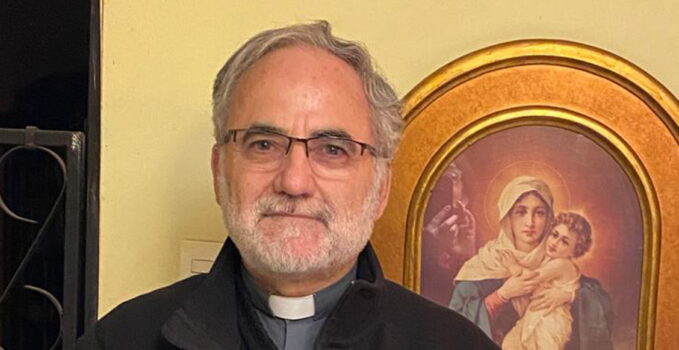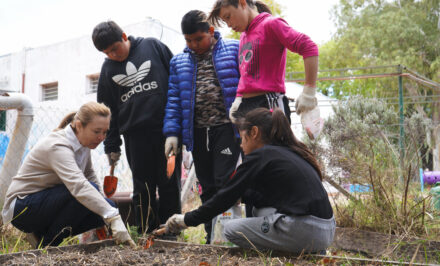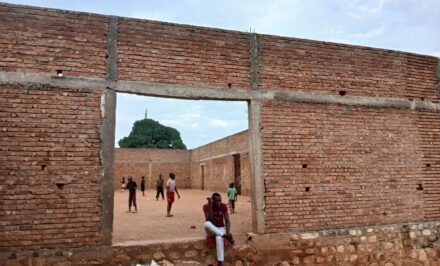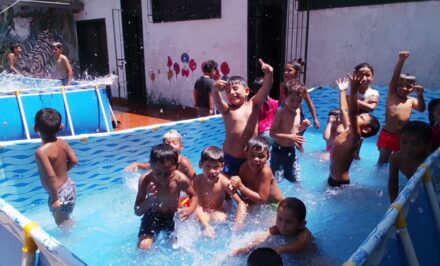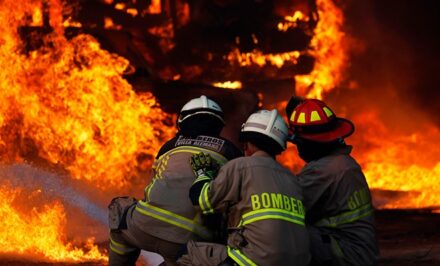CHILE, interview to Fr. Francisco Pereira, by Álvaro Valenzuela P. •
The Community of Schoenstatt Fathers and the Schoenstatt Movement in Chile in general, received with surprise during the beginning of October the great decision made by Father Francisco “Pancho” Pereira. After twenty years as Pastoral Director of the Maria Ayuda Corporation, he decided to step aside and take on new challenges. He says he is very happy with what he has done in these two decades and very hopeful with the challenges that this important institution has to face, which cares for children and adolescents whose rights have been violated and which this year celebrates its fortieth anniversary. —
“Twenty years is a long enough time for a task like this. Father Hernán Alessandri, the founder of María Ayuda, was able to stay twelve years, but he had to give up his task as Pastoral Director, due to his complicated illness. In other words, I have been with Maria Ayuda for more than half of the forty years”, says Father Pancho.
Father Pancho Pereira leaves a legacy that includes the creation of nine shelters for vulnerable children in seven regions of Chile, from Iquique to Temuco. In total, eleven residential programs, one oncology program, and hundreds of children have graduated from these shelters.
What did these twenty years as Pastoral Director of Maria Ayuda mean to you?
In the first place, it meant knowing and living from the inside a totally foreign world, different from what I had ever seen or thought: the world of vulnerable children, a world that few know. A world where you meet children who have been seriously violated in their own families and who have to be referred to protective homes. Children who, through the courts, come to residences like ours because they have been victims and therefore cannot continue where they are. This meant that I was able to identify and get involved body and soul in this reality and make it my own, a wonderful cause that I inherited from Father Hernán. He started it, sowed the seed, laid the foundations, and most importantly offered his life and it fell to me, together with people of great generosity, on the boards and regional councils, to develop it, expand it and make it grow. When I arrived, there was only one home, it was a village or hamlet with ten small houses for seventy girls in Maipú, in addition to the Oncology Home and the school in Puente Alto. Afterwards, the work grew to what it is today, with nineteen residences from north to south. I arrived in 2003 and in 2005, for financing reasons, we joined that great State entity that was Sename, today called Mejor Niñez (Better Childhood). This meant for us to start receiving children with a profile that the system imposed on us, who were much more damaged in their mental health.
A second important thing was to assume, although I never imagined it, to be the external face of this institution, which was very little known at the beginning. I had to be the face to television, to the media in general, and of course to the Schoenstatt Family. I felt that Maria Ayuda and I were one. Finally, it also meant that through my assignment the Community of the Schoenstatt Fathers could take on something that was more in Father Hernán’s own sphere. That is to say, the superiors decided that all the efforts of the social apostolate or concrete works were going to be channeled through Maria Ayuda. It meant that the whole community of Fathers became aware that we had our own fruit that came from Father Hernán Alessandri, a concrete fruit for which we had to worry about, take care of and make it grow. Finally, it also meant fighting, together with others, on hard fronts such as the political, legal, and administrative world, to make visible what was and still is very invisible, the cause of violated children.
Regarding the latter, how did you experience the great Sename crisis when the work of organizations such as yours began to be questioned?
The great Sename crisis brought to light very difficult situations, the result of the weakness and material and human poverty of a system incapable of dealing with the complex situations in the children’s homes. We are talking about abuses, deaths and situations that occurred mainly in the homes under the direct administration of Sename because of their massive size. Then many began to close because the risk of having massive homes was too high. It was understood that large homes with more than a hundred children were impossible to sustain and more family homes were created, but unfortunately this left many children outside of any protection. These children began to be received by private institutions such as ours, which meant other problems for us, such as overcrowding and overcrowding.
The crisis was also influenced by the negative perception that the public began to have of what was happening in the homes, very much influenced by the specific dramas shown by the media. But this also led us, as a Board of Directors, to take the giant step of creating a “model home”, what we would call in our language a “leading case”, in Maria Ayuda, and not to continue doing the same thing. To make Maria Ayuda 2.0. To increase the quality of care, temporarily reduce the number of homes and reach the highest possible level of quality of care. Thus was born the idea of building the first two homes, one in Los Angeles and the other in La Florida, with the seal that we would call “Casa Alma”.
What is Casa Alma and what does it mean to Maria Ayuda?
Casa Alma is a model of home, which includes from the architecture, through the model of care and the change in the profile of professionals, and which implies a strong emphasis on the therapeutic, not only on the psychosocial. We already have two homes with the Casa Alma seal, one in the city of Los Angeles and the other in La Florida, next to the Bellavista Sanctuary. They are homes that want to incorporate neuroscience and psychiatry in their model, without leaving behind the most important aspect, which is spirituality. In these homes there is a pleasant, familiar, and friendly atmosphere. In these places where children sometimes live for many years, the aim is to allow them to heal their wounds and, if possible, to return to their family ties as soon as possible. Casa Alma is a response to the Sename crisis throughout Chile, since this reality cannot be overcome just by changing a name to “Mejor Niñez” (Better Childhood). A residential model of excellence that we want to offer Chile, which is of course more expensive, more pretentious, in every sense, but it is the only way to be able to say that we are taking good care of the children within the drama that this reality entails.
How has the issue of abuse in the Church affected Maria Ayuda?
Abuse has affected the Chilean Church enormously, especially the Chilean Church. And since María Ayuda is a Catholic institution, it also affects us. But our work is precisely to fight against abuses. To welcome the one who has been abused in his family and help him to heal his wounds. So, in the end, people know how to distinguish. It has also forced us to be very strict in our protocols in every way. You can’t skip those protocols, and anything that happens with the staff or between children, no matter how minor, forces you to file a report, which might have been overlooked before. Everything is much more rigorous.
What milestones would you highlight from these 20 years of work?
I think there are several milestones. First, the territorial growth towards the regions. From one home to nineteen in a short period of time is a very strong expansive growth, but it is also due to the dramatic crisis in the system. Sename homes began to close, as well as many Church homes, in each Diocese and the system began to run out of programs to accommodate many children in Chile. Maria Ayuda had to take a leap of audacity and faith in Providence, the voices of time, to go to the support of these children. I had never seen so much precariousness and poverty as in the homes we had to take care of. The second thing is that, together with this growth in each region, nuclei of people from the Schoenstatt Movement and others who were interested in the work and made it their own began to form. This is what we call today the Councils. These and their nuclei of volunteers began to take charge of these homes and were a tremendous support for each home that opened. This meant, at the same time, a wonderful network of links around the work and the person of Father Hernán Alessandri, a network that remains in time.
We began to be known by the public opinion in the media and without realizing it, we were among the three major institutions in Chile in the field of residential homes for children. This also allowed us to have a wide knowledge of the reality and the deficiencies of the system throughout Chile. And this also brought that more people started to become interested and support Maria Ayuda, either financially by becoming members or by participating in the events of each year in each city.
Another important milestone was also the creation of the Father Hernan Alessandri Educational Foundation, with the Joseph Kentenich School in Puente Alto, also founded by Father Hernan. This was a very great achievement of the board of directors, because it gave strength and pull also to the school, which is having success and good results today. In addition, it is the origin, the seed, of a focus of apostolate for the movement in that commune with the “Arde Project” in the vicinity of the school, where a branch of parents and seminarians was recently installed, in addition to the volunteers who go to live there for some time. In other words, there was an extraordinary “creative resultant” there.
What does the figure of Father Hernán Alessandri mean to María Ayuda?
Father Hernán Alessandri was a priest and an extraordinary man. He was an exceptional man, with a thousand qualities and talents. But unfortunately, he died very early and was prostrated for ten years, incommunicado and disconnected from the world, living in our house in Bellavista. He was well known, but only to those of his time. Today Father Hernán has left a tremendous mark: he is known for his books and his testimony. So, to have a founder, for whom this year a process of beatification of his person was opened, gives him a special strength and an extraordinary arrival not only to Maria Ayuda, but also to Schoenstatt and to the Chilean Church. If it is very powerful for Hogar de Cristo to have Father Hurtado, it will also be very powerful for us when Father Hernán Alessandri is known and recognized by the Church. My intention during all these years has been to bring the figure of Father Hernán to María Ayuda, to talk about him, to bring his charism and his mysticism and to bring to life what he wanted in the whole work. It is a great challenge, if we think that more than 350 people work in our institution. It is a great gift, a great treasure that we have to discover and promote.
What things could be improved in the support of vulnerable children?
Today I can tell you clearly that the State alone will not be able to solve the issue of vulnerable children. The State has not made this national problem of children whose rights are violated in their own families a priority in its public policy. It is not in the priorities of any government. Therefore, the great challenge lies with civil society, that is, with us. We have to go out to meet this drama and give it a solution, joining efforts, uniting to put an end to this scourge. But the State must assume that it is impossible to finance this cause without its economic help. A joint effort is required.
But there are also many critical knots that are still pending. What do we see from Maria Ayuda? That, if this is not taken from all angles, from the Judiciary, from public policy, from Mejor Niñez, if there is no joint, intersectoral work, we will not be able to address this problem.
What challenges remain for María Ayuda in the future?
The great challenge is, on the one hand, not to lose the mystique and charisma that Father Hernán gave us. Here there is a spirituality and pedagogy that we know in Schoenstatt, the covenant of love in extreme situations. And on the other hand, to incorporate all the technique, the modernization of the social sciences, neuroscience, psychiatry, because the traumas with which each child arrives are very deep. That is to say, that the “soul” of Maria Ayuda can coexist with the technical actuality of this challenge.
How can Schoenstatters become more involved with Maria Ayuda?
Today Mary Help has a very positive image towards Schoenstatt, which is good for both. That is why it is important to be aware that Maria Ayuda is a very important social arm that is born from the Shrine, which is born from the Covenant of Love, and it is a very clear fruit of it. It is not the only social arm, but it is the largest and most visible. And I believe that there is a responsibility to support the people of Schoenstatt economically and socially, to become members, to participate in the events, to volunteer, to look for alternatives for the apostolate in this work that belongs to everyone. I dream, for example, that tomorrow we will have many host families within the families of the movement, because there are already some cases. But I also believe that there has to be a spiritual involvement, that is, that many can pray for this work, that they can love it, that they can accept it as part of this rich and diverse charism that is born from each Shrine.
How do you see solidarity with the poorest and most helpless in Schoenstatt?
Solidarity in Schoenstatt should have much more visible signs and Maria Ayuda is an opportunity for this. There is a pending debt. We also have to assume that our Marian charism goes through social responsibility, as the Pope asks today. We must assume that evangelization goes through the human promotion of the weakest and poorest in any front that exists. The motto of Mary Helps is very beautiful: “Mary helps the Christ who suffers today”. The Christ who suffers today is the children, but he also has many other faces: the sick, the prostrate elderly, drug addiction, among others. That is why I believe that the Schoenstatter has to go out to the roadside. And I believe that the most beautiful image that Father Hernán left in this sense for all of us is that of the Good Samaritan, the one who approaches the helpless, who helps them and invites others to help him. We have great challenges in this sense.
In every city where Maria Ayuda is present, there is at least one expression of solidarity, but there is still much more to be done. I believe that spirituality must also be linked to charity and fraternal love. Mary who is in Bethlehem, who suffers poverty, Mary who lives with her son Jesus in poverty, Mary who exalts the humble. All the Marian aspect, but also from the point of view of the option for the weakest. Then our sanctuaries have to be places of human promotion where not only people go to pray, but as Father Hernan Alessandri did in 1983 when he founded Maria Ayuda, when he gave food to thousands who came to the Shrine asking for help to subsist.
Source: Vinculo Magazine, November 2023
Original: Spanish. Translation: Maria Fischer @schoenstatt.org


